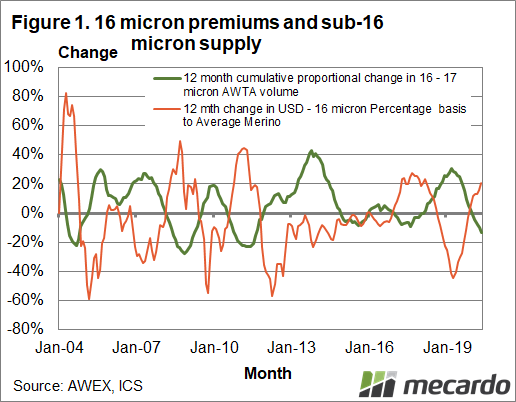Merino prices are down some 40% on year-ago levels, dragged lower by a general downturn in apparel fibre prices to which a pandemic based economic downturn has been added. However not all micron categories are equal. This article looks at changes in the micron premiums and discounts for the Merino categories.
Supply heavily influences the relative prices of greasy wool. In the current market think of yield and its effect on price (see article here) or after wet years the effect of high vegetable matter and subsequent discounts. With changing seasonal conditions, the average fibre diameter swings backwards and forwards, resulting in big changes for wool on the edge of micron distributions.
Figure 1 compares the year on year change in the cumulative supply (AWTA data) over 12 months for 15 micron and finer wool with the year on year change in the premium for 16 micron Merino fleece to the average Merino micron category. As a general rule the micron premium rises as the supply falls and vice versa. Since mid-2019 the cumulative supply of 15 micron and finer wool has been falling with a countervailing improvement in the 16 micron premium.
As Figure 1 shows, supply is not the only driver of micron premiums and discounts, as the relationship is not perfectly synchronised. However it plays a big role, and we can monitor the supply closely. Even better we can forecast 3-5 months forward, as the change in fibre diameter lags seasonal conditions and can guess even further ahead at various times of the year. Rainfall does not have to be very high in the spring of 2020 for seasonal conditions to be improved upon spring 2019, with a resultant increase in the fibre diameter of the Merino clip and decrease in fine wool supply.
Figure 2 shows the micron premiums and discounts, relative to the 19.5 micron price, for sound, combing length fleece for May 2019 and May 2020. The marked increase in micron premiums for 18.5 micron and finer stands out, with the 15 micron premium rising from a depressed 10% to around 60%. Admittedly the overall market is down 40% in price, with the finest end down around 20% and the broader Merino end down by 45%.
Note also the minimal discounts for broad Merino micron categories have widened slightly. The supply of these categories has yet to increase but the fall in supply has moderated, relieving some of the pressure from the market which had reduced these broad micron discounts to near zero.
What does it mean?
A run of dry seasons has resulted in increased supply of fine wool, with decreased premiums as a consequence. Demand does play a role in determining prices overall and relative prices but supply is a major driver of relative prices and should be considered first before thinking about demand. The average Merino micron should increase during 2020 (as we are coming off an extremely dry 2018-2019) and in doing so, push fine Merino volumes lower thereby allowing fine Merino premiums to increase further.
Have any questions or comments?
Key Points
- Amongst the turmoil in the greasy wool market of the past year fine micron premiums have increased markedly.
- Falling supply is helping to push fine micron premiums higher.
- Broad Merino micron discounts have widened as the fall in supply of these categories has eased.
Click on graph to expand
Click on graph to expand
Data sources: AWEX, ICS , Mecardo













